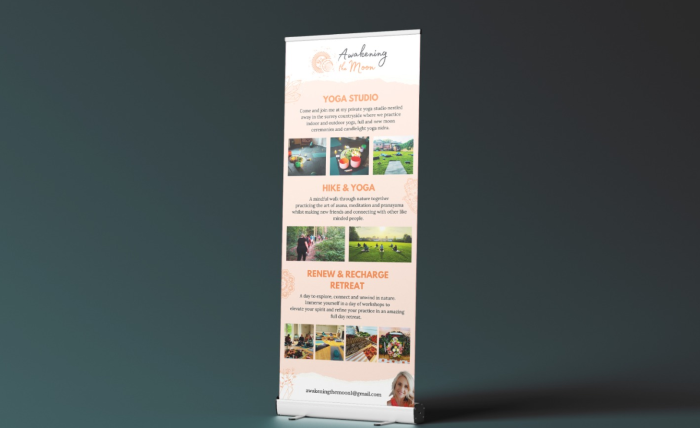
In a crowded marketplace, how do businesses capture attention? Enter roller banners: a powerful yet often underestimated tool for marketing displays. These portable marketing marvels have the potential to not only attract interest but also to ignite conversations that lead to meaningful engagement.
While roller banners are typically viewed as straightforward advertising tools, the real artistry lies in the thoughtful design and strategic placement. Let’s explore how to craft compelling roller banners that elevate brand conversations and drive action.
Understand Your Audience
The first step in creating an effective roller banner is to understand who your audience is. Identify your target demographic—what are their needs, interests, and pain points? This understanding will help you tailor your messaging and visuals to resonate with them.
Consider conducting a brief survey or focus group if you’re unsure about your audience’s preferences. A little research goes a long way in ensuring that your message is on point. For example, if you’re targeting young professionals, vibrant colours and contemporary imagery might work best.
The Elements of Design
Once you’ve pinpointed your audience, it’s time to focus on design. The key elements include:
- Visual Hierarchy: Your banner should guide the viewer’s eye. Start with a captivating headline that draws attention, followed by visuals that complement your message. A great headline paired with an engaging image can create that initial spark of interest.
- Concise Messaging: Keep your text brief and impactful. Use bullet points or short sentences to convey your message clearly. Limiting the amount of text allows viewers to grasp your key points quickly. Remember, less is often more.
- Call to Action (CTA): A strong CTA is crucial. Whether it’s “Visit our website” or “Claim your discount,” your CTA should be direct and compelling. But don’t just state the action; explain why the viewer should follow through. For instance, “Join us for a free consultation that could transform your business” adds incentive.
Choosing the Right Materials
High-quality materials can make a meaningful difference in how your roller banner is perceived. Opt for durable, weather-resistant materials that ensure longevity, especially if they’re getting regular use in various settings.
Additionally, consider the mechanism of the banner itself. Easy setup marketing stands, which allow for quick and hassle-free assembly, are a great investment for any business looking to make a strong impression without a complicated setup process. You can find a variety of options that suit different needs, from lightweight designs suited for events to more sturdy versions for frequent use.
Placement Matters
Even the best-designed roller banner can fail to generate interest if it’s not displayed in the right location. Think strategically about where and when you’ll deploy your banner. Modern conventions, trade shows, and even community events are all excellent venues.
Also consider foot traffic; banners should be placed where they can catch the eyes of passersby. If possible, place your banner at eye level to maximise visibility. A roller banner in a busy entranceway or by a prominent sign-in table can significantly increase interactions.
Engage Your Audience
Your roller banner shouldn’t just be a static piece of marketing. Use it as a conversation starter. Train your team to engage with viewers by asking questions or offering mini-presentations based on the information displayed.
Consider incorporating QR codes or social media hashtags that encourage interaction. This not only brings your banner to life but also directs traffic to your online platforms, fostering a two-way communication channel.
Evaluate and Iterate
After deploying your roller banners, it’s essential to evaluate their performance. Pay attention to the conversations they spark and track any measurable outcomes, such as traffic to your website or social media mentions.
Gather feedback from your team and the audience alike. What worked? What didn’t? This insight is invaluable for refining future designs and strategies. Continuous improvement will ensure that your roller banners remain effective tools for engagement.
Case Studies
To illustrate the power of roller banners, consider a few real-life examples:
1 Tech Start-up: A local software company used roller banners at a tech fair, incorporating interactive elements. They featured a QR code that led to a downloadable demo of their product. The result? A 30% increase in downloads during the event.
2 Non-Profit Initiative: An environmental charity created impactful roller banners for community outings, showcasing not just their mission but also inviting volunteers to sign up on the spot. This led to a significant uptick in volunteer applications and community engagement.
3 Retail Business: A clothing line utilised roller banners in-store, highlighting limited-time offers. By including vibrant visuals and a clear CTA, they saw a notable increase in foot traffic and sales.
Conclusion
Roller banners, when crafted with intention and strategic foresight, can serve as powerful tools for conversation and action. From understanding your audience and designing effective visuals to placing them thoughtfully and engaging with your viewers, there are numerous ways to enhance their impact.
Ultimately, the goal is not just to inform, but to inspire and engage. If you leverage roller banners effectively, you can transform them into a catalyst for brand growth and customer interaction. Whether you’re at a bustling exhibition or a quiet rural community event, these versatile tools can shift perceptions and ignite conversations that lead to lasting business relationships.




